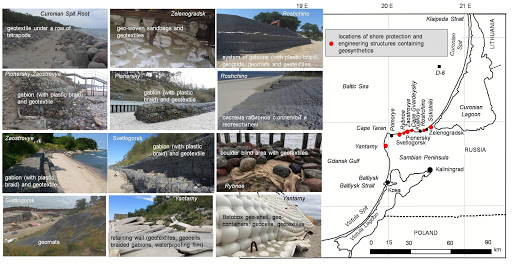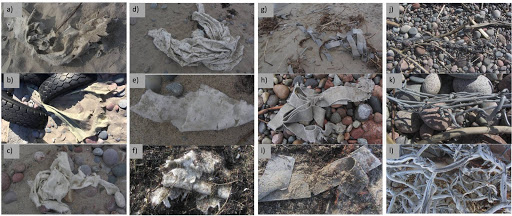EI-GEO (RFBR 18-55-76002)
The project EI-GEO “Environmental impact of geosynthetics in aquatic systems” of the Program ERA.Net RUS Plus (No RUS_ST2017-212) (RFBR via grant No. 18-55-76002, 2018-2020), Germany (The Federal Institute for Materials Research and Testing (BAM)), Latvia (Latvian Institute of Aquatic Ecology (LIAE)) and Russia (P.P. Shirshov Institute of Oceanology of Russian Academy of Sciences (SIO)
Geosynthetics are widely used in hydraulic engineering and within coastal protection constructions at the Baltic Sea shore, such as embankments, gabions walls, seawalls, offshore breakwaters, artificial reefs, and other. There are main categories of the geosynthetics (geotextiles, geocells, geogrids, geocomposites, geonets, geomembranes, geosynthetic clay liners, geofoam and drainage / infiltration cells) are used in the soil for filtration, drainage, separation, reinforcement and stabilization purposes.
Storms influence leads to deformation of some of the protection structures and cause the release of geotextiles onto the beach. Fragments of geotextile migrate along the shore, experiencing additional degradation and destruction down to macro-, meso-, and micro-particles. During October 2017 – March 2020, the Baltic Sea shore along the Sambia Peninsula (Kaliningrad Oblast of the Russian Federation) was monitored to establish the contamination of sandy beaches by geotextiles that had degraded. Several local sources of pollution of beaches by geosynthetic materials were established, namely, the coastal protection constructions located on the shore of the Sambia Peninsula (Fig. 1.).
Worn geosynthetic materials are broken under the wind-wave action, and its parts migrate over long distances along the shore of the region (Fig. 2.). This geosynthetics undergoes photodegradation, thermo oxidation, hydrolysis, biodegradation, abrasion, and thus becomes torn and breaks up into smaller parts (Fig. 3). Fibres from disheveled geotextiles and fragments from deformed and broken geosynthetic materials are easily separated and transferred into another size range – from mega/macroplastics to meso/microplastics.

Fig. 1.Study area in South-Eastern Baltic (Kaliningrad Oblast of Russian Federation) and locations where protection constructions containing geotextiles exist (Photos by Esiukova E.)

Fig. 2. Deformed geotextiles (from coast protection structures) which are migrated along the shore: nonwoven geotextiles (a-f), geocells from the slope in Pionersky (g-i) , and the fragments of geosynthetics from the gabions metal nets with plastic coating (j-l) (Photos by Esiukova E.)

Fig. 3. Deformed geosynthetics and geotextiles from coast protection structures on the shore nearby the gambling zone “Amber” (November-December 2019): (a-b) fiberglass composite panels from the boardwalk in Pionersky, (c) big-beg, (d-f) nonwoven geotextiles, (f-i) ropes, nets, fishing tackles and plastic coating from the gabions (Photos by Esiukova E and Esiukov O.).
References:
Esiukova E., Chubarenko B., Simon F.-G. Debris of geosynthetic materials on the shore of South-Eastern Baltic (Kaliningrad Oblast, Russian Federation) // 2018 IEEE/OES Baltic International Symposium (BALTIC). 2018. P. 1-6. DOI: 10.1109/BALTIC.2018.8634842.
Esiukova E. E., Chubarenko B. V., Burnashov E. M. Geosynthetic materials as a source of pollution of the marine environment by plastic debris. Regional Ecology, 2018, no. 3(53), pp. 15–28 (In Russian). DOI: 10.30694/1026-5600-2018-3-15-28
